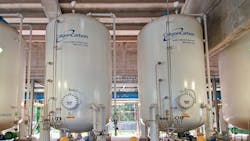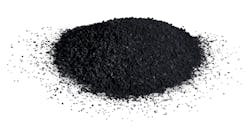How utilities can comply with EPA’s proposed PFAS MCLs
The U.S. EPA’s recent release of draft Maximum Containment Levels (MCLs) for per- and Polyfluoroalkyl substances (PFAS) — the agency’s first attempt to establish legally enforceable levels on a national scale for six PFAS compounds in drinking water — inevitably leads to questions about their future impact on the water treatment industry.
What are PFAS and how (and when) would MCLs help to combat them? Here, we’ll explore those questions and summarize the best-available treatment technologies to help water utilities meet the proposed criteria.
PFAS have captured the attention of the water treatment industry for years. These man-made chemicals have varying numbers of carbon-fluorine bonds present in their chemical structure, with more than 6,000 species in their class of chemicals. Two of the most studied PFAS are PFOA and PFOS due to their wide industrial usage. But this class also includes PFNA, PFHxS, PFBS, and HFPO-DA (GenX), which are all subjects of EPA’s proposed MCLs.
The carbon-fluorine bond gives these compounds unique properties that make them useful in a wide range of applications, including fire suppression foam, waterproofing materials, grease repellants, and specialty applications in the electronics industry. The carbon-fluorine bond also makes these compounds extremely persistent in the environment (leading to PFAS sometimes being referred to as “forever chemicals”) and bioaccumulative in humans and animals where they have been found to cause negative health effects at very low levels.
EPA’s proposed MCLs
Regarding the draft MCLs, it is important to note that they are just that: a draft. They are anticipated to be finalized toward the end of 2023 following a review period. At that point, there will likely be an implementation period of several years to allow water utilities to engineer and design solutions capable of meeting the new MCLs.
The second item to emphasize is that this standard will be enforceable, not just a guideline; previously, EPA offered Health Advisory Levels (HALs) for these compounds, but the HALs lacked real teeth because they did not require treatment to meet those limits. Once EPA’s MCLs are finalized and implemented, drinking water sources will require monitoring and treatment if found to be above those levels.
The third item to stress is that these MCLs will be national standards for treatment. While 22 states have implemented their own MCLs for several PFAS, requiring treatment for drinking water sources that exceed the threshold, states without or with higher MCLs will have enforceable limits at the federal level once the MCLs take effect.
The current EPA draft MCLs are < 4 ppt (ng/L) for PFOS, < 4 ppt for PFOA, and a hazard index approach for GenX, PFHxS, PFNA, and PFBS.
For some perspective on the magnitude of these units, consider that one part per trillion (ppt) is equivalent to one droplet of water in an Olympic-sized swimming pool.PFAS treatment options
In establishing these limits, a key factor was whether the treatment objectives (i.e., < 4 ppt) are achievable with technologies readily available on the market. While the draft federal MCLs are new, the good news is there are several proven treatment options and partners with experience in treating to these levels. EPA currently has three Best Available Treatment (BAT) technologies commonly used for addressing PFAS in drinking water: granular activated carbon (GAC), ion exchange resin (IX), and high-pressure membranes, commonly referred to as reverse osmosis (RO) filtration.
When selecting a technology for PFAS treatment, it is critical to consider that every water stream is unique, so testing is recommended to determine the ideal solution for your site. Various factors to consider are the incoming PFAS and their concentrations, the background water quality (including total organic carbon and the presence of anions/cations that can impact different technologies), co-contaminants that may be present that also require removal, and any site-specific limitations (footprint as an example). Below, we consider the advantages and disadvantages of each option.
Granular activated carbon (GAC)
Having been in use for more than 20 years, GAC is a well-established and proven technology to remove PFAS from drinking water and wastewater streams. Properly designed systems can (and have) met the proposed federal MCL levels.
A properly designed system includes a particular emphasis on the GAC (mesh size, raw material/type of GAC and activity), the correct size of the system to ensure appropriate contact time for PFAS applications, and that the media is replaced appropriately. Reagglomerated bituminous coal-based materials have been proven significantly more consistent and effective for PFAS than other types of GAC.
GAC is generally the lowest-cost treatment option and, with reactivation of the spent carbon, PFAS can be removed from the GAC with >99.99% destruction through a properly controlled, high-temperature thermal reactivation process. Further, reactivation allows the GAC to be reused in appropriate applications, which has both sustainability and cost-saving benefits when compared to other technologies that require used media to be either landfilled, incinerated, or removed with some other disposal option.
In addition to PFAS removal, GAC can also remove a wide array of other organic compounds from water, such as pesticides/herbicides, algal toxins, DBPs and many others. From an operational lens, a GAC system is simple to operate and can manage a wide range of stream characteristics (suspended solids, oxidants, etc).
The downside to GAC is that it has the largest physical footprint of the three treatment technologies.
Ion exchange (IX)
IX is another technology that has been deployed for PFAS treatment in recent years.
The large advantage for IX is it generally requires a smaller footprint than GAC. The downside, however, is that IX is not effective in removing organics from water, so its ability to remove co-contaminants is restricted to charged species, such as nitrates.
From an operational perspective, many resins are not capable of withstanding disinfection (should one be necessary, it would destroy the resin) and robust pretreatment is often required to reduce suspended solids, as the resin is unable to be backwashed in service. IX is generally more costly than GAC because of the significantly higher unit cost, and the material must be landfilled, incinerated, or removed with other disposal means.
Reverse osmosis (RO)
RO uses a high-pressure force to push the stream through a membrane that separates particles greater than 0.1 nanometers in size from the water, such as PFAS.
It consumes a large amount of energy to operate this technology at the required pressures, creates a problematic concentrated waste stream that must be treated further, strips the water of many healthy minerals, and reduces the pH of the water, making it more corrosive to plumbing systems. The membrane can also be scaled or damaged by constituents present in the water stream, which could require installing additional unit operations ahead of this technology.
Conclusion
While the draft MCLs may appear daunting at first read, there are proven cost-effective technologies and service providers to treat PFAS to the required levels. As we move into single-digit part-per-trillion treatment objectives, it’s important to note that nuances in design and operation have become increasingly important. Companies such as Calgon Carbon have decades of experience treating PFAS effectively using activated carbon and ion exchange resins.
About the Author

John Matthis
John Matthis is the director of global business development for Calgon Carbon Corporation. He spearheads the Calgon Carbon PFAS task force and has contributed to the book Perfluoroalkyl Substances in the Environment Theory, Practice, and Innovation, 2018. He has conducted more than 10 webinars on PFAS treatment with activated carbon and has spoken at NEWMOA PFAS Technical Workshop (2017), the 33rd International Conference on Solid Waste Technology and Management (2018), and the International Water Conference (2021). Matthis earned his double BS in Chemistry and Mathematics from Duquesne University, his MBA from the University of Pittsburgh, and his MS in Chemical Engineering from the University of Pittsburgh.

